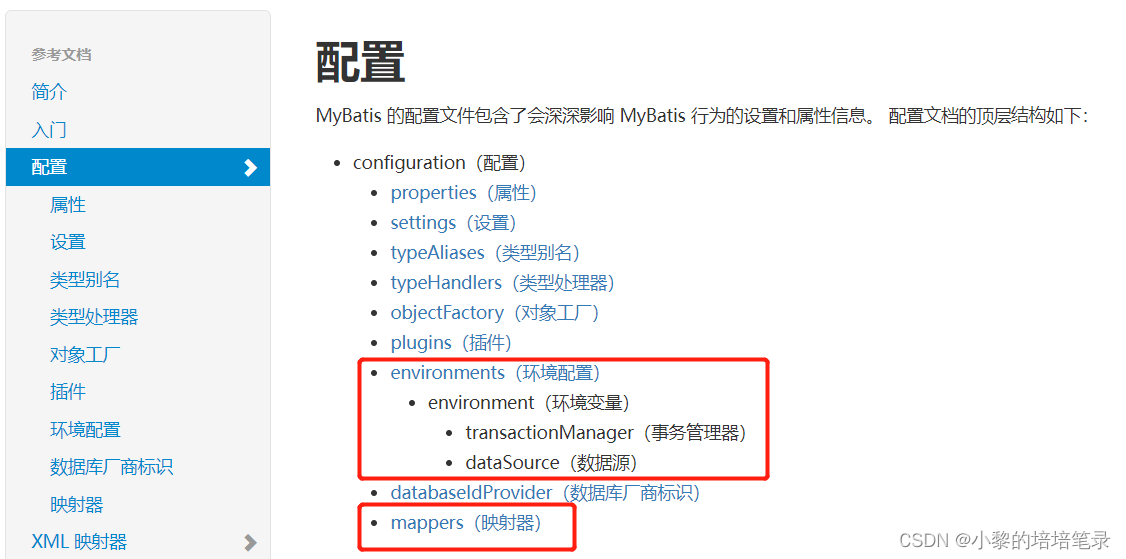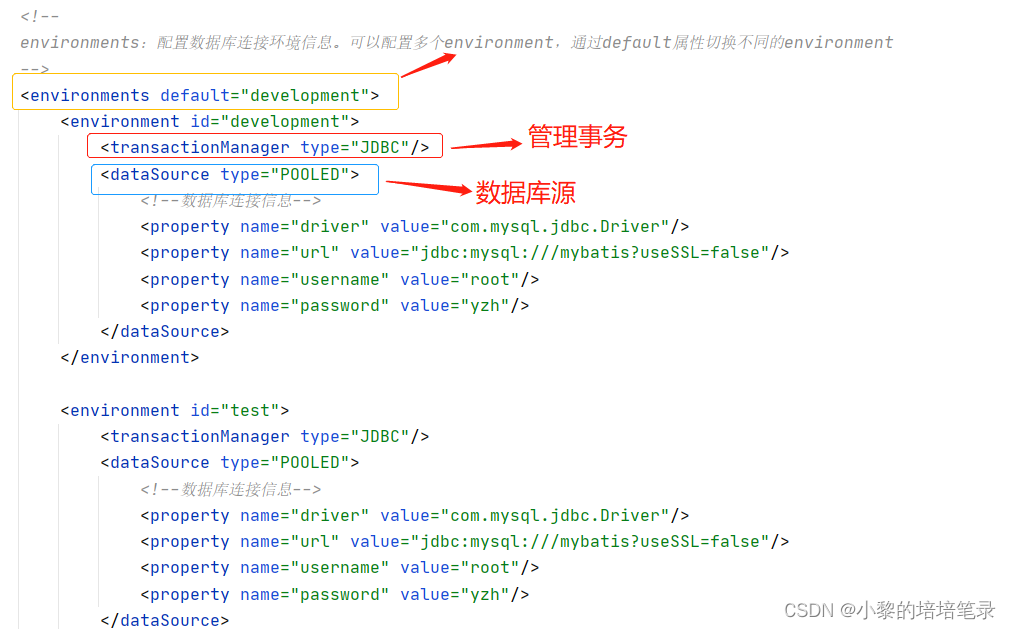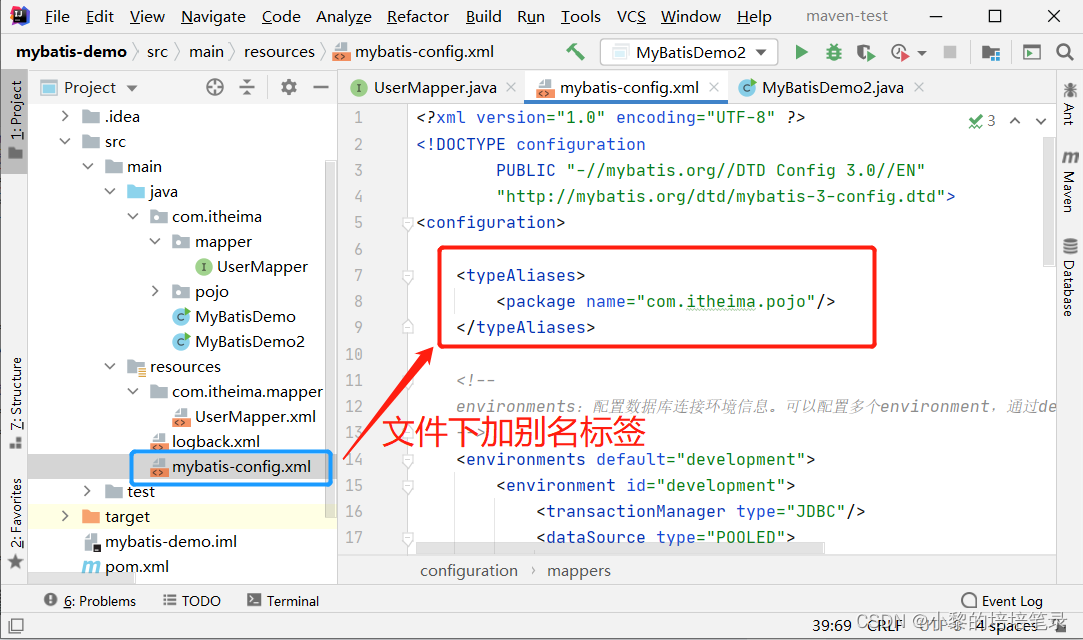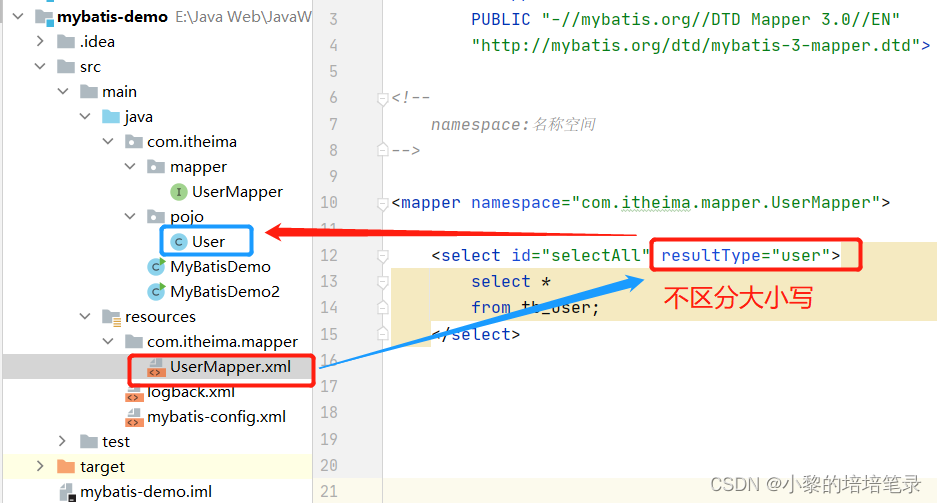一、MyBatis 配置
1、核心配置文件
▶ 官网上可以看配置
** 注意:配置各个标签需要遵循官网的配置顺序,否则会报错。**
▶ 环境配置
2、配置别名
二、配置文件完成CRUD
1、查询操作
▶ 查询所有数据
▷ 书写步骤
编写接口方法:Mapper接口 * 参数:无,(查询所有数据功能是不需要根据任何条件进行查询的,所以此方法不需要参数)。
* 结果:List<Brand> ,(我们会将查询出来的每一条数据封装成一个 `Brand` 对象,而多条数据封装多个 `Brand` 对象,需要将这些对象封装到List集合中返回)。 * 编写SQL语句:SQL映射文件
* 执行方法、测试** ▷ 编写接口**
在 `com.itheima.mapper` 包写创建名为 `BrandMapper` 的接口。并在该接口中定义 `List<Brand> selectAll()` 方法。自己写的时候注意接口的位置写到什么地方。public interface BrandMapper { List<Brand> selectAll(); }▷ 编写SQL语句
在 `reources` 下创建 `com/itheima/mapper` 目录结构,并在该目录下创建名为 `BrandMapper.xml` 的映射配置文件。自己写的时候找到对应的SQL书写映射文件。<mapper namespace="com.itheima.mapper.BrandMapper"> <select id="selectAll" resultType="brand"> select * from tb_brand; </select> </mapper>▷ 测试方法
在 `MybatisTest` 类中编写测试查询所有的方法,在测试类中进行测试。public void testSelectAll() throws IOException { //1. 获取SqlSessionFactory String resource = "mybatis-config.xml"; InputStream inputStream = Resources.getResourceAsStream(resource); SqlSessionFactory sqlSessionFactory = new SqlSessionFactoryBuilder().build(inputStream); //2. 获取SqlSession对象 SqlSession sqlSession = sqlSessionFactory.openSession(); //3. 获取Mapper接口的代理对象 BrandMapper brandMapper = sqlSession.getMapper(BrandMapper.class); //4. 执行方法 List<Brand> brands = brandMapper.selectAll(); System.out.println(brands); //5. 释放资源 sqlSession.close(); }** ▷ 执行结果**
存在的问题:从上面结果可以看到
brandName和companyName这两个属性的数据没有封装成功,查询 实体类 和 表中的字段 发现,在实体类中属性名是brandName和companyName,而表中的字段名为brand_name和company_name,那么我们只需要保持这两部分的名称一致这个问题就迎刃而解。** ▷ 解决方式**
**数据库表的字段名称 和 实体类的属性名称 不一样,则不能自动封装数据: ①起别名:对不一样的列名起别名,让别名和实体类的属性名一样。缺点:每次查询都要定义一次别名**<select id="selectAll" resultType="brand"> select id, brand_name as brandName, company_name as companyName, ordered, description, status from tb_brand; </select>**sql片段,缺点:不灵活**<sql id="brand_column"> id, brand_name as brandName, company_name as companyName, ordered, description, status </sql> <select id="selectAll" resultType="brand"> select <include refid="brand_column" /> from tb_brand; </select>**②resultMap: 1. 定义<resultMap>标签 2. 在<select>标签中,使用resultMap属性替换 resultType属性**<!-- id:唯一标识,type:映射的类型,支持别名 --> <resultMap id="brandResultMap" type="brand"> <result column="brand_name" property="brandName"/> <result column="company_name" property="companyName"/> </resultMap> <select id="selectAll" resultMap="brandResultMap"> select * from tb_brand; </select>** id:完成主键字段的映射 column:表的列名 property:实体类的属性名 result:完成一般字段的映射 column:表的列名 property:实体类的属性名**▶ 查询详情
▷ 编写步骤
编写接口方法:Mapper接口
* 参数:id 查看详情就是查询某一行数据,所以需要根据id进行查询。而id以后是由页面传递过来。
* 结果:Brand 根据id查询出来的数据只要一条,而将一条数据封装成一个Brand对象即可 * 编写SQL语句:SQL映射文件
* 执行方法、进行测试** ▷ 编写接口**
Brand selectById(int id);** ▷ 编写SQL语句**
<select id="selectById" resultMap="brandResultMap"> select * from tb_brand where id = #{id}; </select>** ▷ 测试方法**
public void testSelectById() throws IOException { //接收参数 int id = 1; //1. 获取SqlSessionFactory String resource = "mybatis-config.xml"; InputStream inputStream = Resources.getResourceAsStream(resource); SqlSessionFactory sqlSessionFactory = new SqlSessionFactoryBuilder().build(inputStream); //2. 获取SqlSession对象 SqlSession sqlSession = sqlSessionFactory.openSession(); //3. 获取Mapper接口的代理对象 BrandMapper brandMapper = sqlSession.getMapper(BrandMapper.class); //4. 执行方法 Brand brand = brandMapper.selectById(id); System.out.println(brand); //5. 释放资源 sqlSession.close(); }▷ 参数占位符
1. #{}: 会将其替换为 ?,为了防止SQL注入
2. ${}:拼sql。会存在SQL注入问题
3. 使用时机:
* 参数传递的时候:#{}
* 表名或者列名不固定的情况下:${} 会存在SQL注入问题4.参数类型:parameterType:可以省略 5.特殊字符处理:(比如:< ) * 转义字符:< * CDATA区 : <![CDATA[ < ]]>▶ 多条件查询
** ▷ 书写步骤**
1、编写接口方法 * 参数:所有查询条件 * 结果:List<Brand> 2、在映射配置文件中编写SQL语句 3、编写测试方法并执行▷ 编写接口
①使用
@Param("参数名称")标记每一个参数,在映射配置文件中就需要使用#{参数名称}进行占位List<Brand> selectByCondition(@Param("status") int status, @Param("companyName") String companyName, @Param("brandName") String brandName);②将多个参数封装成一个 实体对象 ,将该实体对象作为接口的方法参数。该方式要求在映射配置文件的SQL中使用
#{内容}时,里面的内容必须和实体类属性名保持一致。List<Brand> selectByCondition(Brand brand);③将多个参数封装到map集合中,将map集合作为接口的方法参数。该方式要求在映射配置文件的SQL中使用
#{内容}时,里面的内容必须和map集合中键的名称一致。List<Brand> selectByCondition(Map map);** ▷ 编写SQL语句**
<select id="selectByCondition" resultMap="brandResultMap"> select * from tb_brand where status = #{status} and company_name like #{companyName} and brand_name like #{brandName} </select>** ▷ 进行测试**
public void testSelectByCondition() throws IOException { //接收参数 int status = 1; String companyName = "华为"; String brandName = "华为"; // 处理参数 companyName = "%" + companyName + "%"; brandName = "%" + brandName + "%"; //1. 获取SqlSessionFactory String resource = "mybatis-config.xml"; InputStream inputStream = Resources.getResourceAsStream(resource); SqlSessionFactory sqlSessionFactory = new SqlSessionFactoryBuilder().build(inputStream); //2. 获取SqlSession对象 SqlSession sqlSession = sqlSessionFactory.openSession(); //3. 获取Mapper接口的代理对象 BrandMapper brandMapper = sqlSession.getMapper(BrandMapper.class); //4. 执行方法 List<Brand> brands = brandMapper.selectByCondition(status, companyName, brandName); System.out.println(brands); //5. 释放资源 sqlSession.close();//封装对象 Brand brand = new Brand(); brand.setStatus(status); brand.setCompanyName(companyName); brand.setBrandName(brandName); //4.执行方法 List<Brand> brands = brandMapper.selectByCondition(brand);Map map = new HashMap(); map.put("status" , status); map.put("companyName", companyName); map.put("brandName" , brandName); //4.执行方法 List<Brand> brands = brandMapper.selectByCondition(map);** ▷ 动态SQL**
① if 标签:条件判断,其中test 属性:逻辑表达式。
<select id="selectByCondition" resultMap="brandResultMap"> select * from tb_brand where <if test="status != null"> and status = #{status} </if> <if test="companyName != null and companyName != '' "> and company_name like #{companyName} </if> <if test="brandName != null and brandName != '' "> and brand_name like #{brandName} </if> </select>② where 标签,作用: 替换where关键字, 会动态的去掉关键字 ,* 如果所有的参数没有值则不加where关键字**
<select id="selectByCondition" resultMap="brandResultMap"> select * from tb_brand <where> <if test="status != null"> and status = #{status} </if> <if test="companyName != null and companyName != '' "> and company_name like #{companyName} </if> <if test="brandName != null and brandName != '' "> and brand_name like #{brandName} </if> </where> </select>▶ 单个条件的动态SQL
** ▷ 编写接口**
List<Brand> selectByConditionSingle(Brand brand);** ▷ 编写SQL**
<select id="selectByConditionSingle" resultMap="brandResultMap"> select * from tb_brand <where> <choose><!--相当于switch--> <when test="status != null"><!--相当于case--> status = #{status} </when> <when test="companyName != null and companyName != '' "><!--相当于case--> company_name like #{companyName} </when> <when test="brandName != null and brandName != ''"><!--相当于case--> brand_name like #{brandName} </when> </choose> </where> </select>** ▷ 测试方法**
public void testSelectByConditionSingle() throws IOException { //接收参数 int status = 1; String companyName = "华为"; String brandName = "华为"; // 处理参数 companyName = "%" + companyName + "%"; brandName = "%" + brandName + "%"; //封装对象 Brand brand = new Brand(); brand.setCompanyName(companyName); //1. 获取SqlSessionFactory String resource = "mybatis-config.xml"; InputStream inputStream = Resources.getResourceAsStream(resource); SqlSessionFactory sqlSessionFactory = new SqlSessionFactoryBuilder().build(inputStream); //2. 获取SqlSession对象 SqlSession sqlSession = sqlSessionFactory.openSession(); //3. 获取Mapper接口的代理对象 BrandMapper brandMapper = sqlSession.getMapper(BrandMapper.class); //4. 执行方法 List<Brand> brands = brandMapper.selectByConditionSingle(brand); System.out.println(brands); //5. 释放资源 sqlSession.close(); }
2、添加操作
** ▶ 编写接口**
void add(Brand brand);** ▶ 编写SQL**
<insert id="add"> insert into tb_brand (brand_name, company_name, ordered, description, status) values (#{brandName}, #{companyName}, #{ordered}, #{description}, #{status}); </insert>** ▶ 测试方法**
public void testAdd() throws IOException { //接收参数 int status = 1; String companyName = "波导手机"; String brandName = "波导"; String description = "手机中的战斗机"; int ordered = 100; //封装对象 Brand brand = new Brand(); brand.setStatus(status); brand.setCompanyName(companyName); brand.setBrandName(brandName); brand.setDescription(description); brand.setOrdered(ordered); //1. 获取SqlSessionFactory String resource = "mybatis-config.xml"; InputStream inputStream = Resources.getResourceAsStream(resource); SqlSessionFactory sqlSessionFactory = new SqlSessionFactoryBuilder().build(inputStream); //2. 获取SqlSession对象 SqlSession sqlSession = sqlSessionFactory.openSession(); //3. 获取Mapper接口的代理对象 BrandMapper brandMapper = sqlSession.getMapper(BrandMapper.class); //4. 执行方法 brandMapper.add(brand); //提交事务 sqlSession.commit(); //5. 释放资源 sqlSession.close(); }▶ 主键返回
在数据添加成功后,有时候需要获取插入数据库数据的主键(主键是自增长)。比如:
添加订单数据
添加订单项数据,订单项中需要设置所属订单的id
▷ 更改SQL<insert id="add" useGeneratedKeys="true" keyProperty="id"> insert into tb_brand (brand_name, company_name, ordered, description, status) values (#{brandName}, #{companyName}, #{ordered}, #{description}, #{status}); </insert>▷ 在 insert 标签上添加如下属性: * useGeneratedKeys:是够获取自动增长的主键值。true表示获取 * keyProperty :指定将获取到的主键值封装到哪儿个属性里
3、修改操作
** ▶ 编写接口**
void update(Brand brand);** ▶ 编写SQL**
<update id="update"> update tb_brand <set> <if test="brandName != null and brandName != ''"> brand_name = #{brandName}, </if> <if test="companyName != null and companyName != ''"> company_name = #{companyName}, </if> <if test="ordered != null"> ordered = #{ordered}, </if> <if test="description != null and description != ''"> description = #{description}, </if> <if test="status != null"> status = #{status} </if> </set> where id = #{id}; </update>** ▶ 测试方法**
public void testUpdate() throws IOException { //接收参数 int status = 0; int id = 6; //封装对象 Brand brand = new Brand(); brand.setStatus(status); brand.setId(id); //1. 获取SqlSessionFactory String resource = "mybatis-config.xml"; InputStream inputStream = Resources.getResourceAsStream(resource); SqlSessionFactory sqlSessionFactory = new SqlSessionFactoryBuilder().build(inputStream); //2. 获取SqlSession对象 SqlSession sqlSession = sqlSessionFactory.openSession(); //3. 获取Mapper接口的代理对象 BrandMapper brandMapper = sqlSession.getMapper(BrandMapper.class); //4. 执行方法 int count = brandMapper.update(brand); System.out.println(count); //提交事务 sqlSession.commit(); //5. 释放资源 sqlSession.close(); }
4、删除操作
▶ 单行删除
** ▷ 编写接口**
void deleteById(int id);** ▷ 编写SQL**
<delete id="deleteById"> delete from tb_brand where id = #{id}; </delete>** ▷ 测试方法**
public void testDeleteById() throws IOException { //接收参数 int id = 6; //1. 获取SqlSessionFactory String resource = "mybatis-config.xml"; InputStream inputStream = Resources.getResourceAsStream(resource); SqlSessionFactory sqlSessionFactory = new SqlSessionFactoryBuilder().build(inputStream); //2. 获取SqlSession对象 SqlSession sqlSession = sqlSessionFactory.openSession(); //SqlSession sqlSession = sqlSessionFactory.openSession(true); //3. 获取Mapper接口的代理对象 BrandMapper brandMapper = sqlSession.getMapper(BrandMapper.class); //4. 执行方法 brandMapper.deleteById(id); //提交事务 sqlSession.commit(); //5. 释放资源 sqlSession.close(); }▶ 批删除除
** ▷ 编写接口**
void deleteByIds(int[] ids);** ▷ 编写SQL:foreach 标签**
用来迭代任何可迭代的对象(如数组,集合):
①collection 属性:
* mybatis会将数组参数,封装为一个Map集合。
* 默认:array = 数组
* 使用@Param注解改变map集合的默认key的名称
②item 属性:本次迭代获取到的元素。
③separator 属性:集合项迭代之间的分隔符。foreach标签不会错误地添加多余的分隔符。也就是最后一次迭代不会加分隔符。
④open 属性:该属性值是在拼接SQL语句之前拼接的语句,只会拼接一次
⑤close 属性:该属性值是在拼接SQL语句拼接后拼接的语句,只会拼接一次<delete id="deleteByIds"> delete from tb_brand where id in <foreach collection="array" item="id" separator="," open="(" close=")"> #{id} </foreach> ; </delete>** ▷ 测试方法**
public void testDeleteByIds() throws IOException { //接收参数 int[] ids = {5,7,8}; //1. 获取SqlSessionFactory String resource = "mybatis-config.xml"; InputStream inputStream = Resources.getResourceAsStream(resource); SqlSessionFactory sqlSessionFactory = new SqlSessionFactoryBuilder().build(inputStream); //2. 获取SqlSession对象 SqlSession sqlSession = sqlSessionFactory.openSession(); //SqlSession sqlSession = sqlSessionFactory.openSession(true); //3. 获取Mapper接口的代理对象 BrandMapper brandMapper = sqlSession.getMapper(BrandMapper.class); //4. 执行方法 brandMapper.deleteByIds(ids); //提交事务 sqlSession.commit(); //5. 释放资源 sqlSession.close(); }
5、MyBatis参数传递
▶ 多个参数
我们在接口方法中定义多个参数,Mybatis 会将这些参数封装成 Map 集合对象,值就是参数值,而键在没有使用
@Param注解时有以下命名规则:▷ 以 arg 开头 :第一个参数就叫 arg0,第二个参数就叫 arg1,以此类推。如:
map.put("arg0",参数值1);
map.put("arg1",参数值2);▷ 以 param 开头 : 第一个参数就叫 param1,第二个参数就叫 param2,依次类推。如:
map.put("param1",参数值1);
map.put("param2",参数值2);① 验证一:
接口:
User select(String username,String password);SQL:
<select id="select" resultType="user"> select * from tb_user where username=#{arg0} and password=#{arg1} </select>或
<select id="select" resultType="user"> select * from tb_user where username=#{param1} and password=#{param2} </select>结果:
② 验证二:
将接口更改:User select(@Param("username") String username, String password);则会看到下列运行结果
结论:以后接口参数是多个时,在每个参数上都使用
@Param注解。这样代码的可读性更高。▶ 单个参数
▷ POJO 类型
直接使用。要求 `属性名` 和 `参数占位符名称` 一致▷ Map 集合类型
直接使用。要求 `map集合的键名` 和 `参数占位符名称` 一致▷ Collection 集合类型
Mybatis 会将集合封装到 map 集合中,如下: * map.put("arg0",collection集合); * map.put("collection",collection集合; ==》可以使用 `@Param` 注解替换map集合中默认的 arg 键名。▷ List 集合类型
Mybatis 会将集合封装到 map 集合中,如下: * map.put("arg0",list集合); * map.put("collection",list集合); * map.put("list",list集合); ==》可以使用 `@Param` 注解替换map集合中默认的 arg 键名。▷ Array 类型
Mybatis 会将集合封装到 map 集合中,如下: * map.put("arg0",数组); * map.put("array",数组); ==》可以使用 `@Param` 注解替换map集合中默认的 arg 键名。==▷ 其他类型
比如int类型,`参数占位符名称` 叫什么都可以。尽量做到见名知意
三、注解实现CRUD
▷ 注解实现
@Select(value = "select * from tb_user where id = #{id}") public User select(int id);▷ 注意
注解是用来替换映射配置文件方式配置的,所以使用了注解,就不需要再映射配置文件中书写对应的 `statement`。▷ Mybatis 针对 CURD 操作都提供了对应的注解。如下:
查询 :@Select 添加 :@Insert 修改 :@Update 删除 :@Delete** ▷ 注解实现方式**
在接口中直接这样写:
@Select(value = "select * from tb_user where id = #{id}") public User select(int id);而编写SQL语句的那个配置文件就不需要在写SQL语句了。
▷ 注解完成简单功能,配置文件完成复杂功能。
版权归原作者 小黎的培培笔录 所有, 如有侵权,请联系我们删除。














